Method of reprocessing quaternary ammonium-containing neuromuscular blocking agents
a neuromuscular blocking agent and quaternary ammonium technology, applied in the field of reprocessing neuromuscular blocking agents, can solve the problems of significant challenges associated with purification on a commercial scale, and difficult precipitation or crystallization of rocuronium bromide, etc., to achieve convenient purification
- Summary
- Abstract
- Description
- Claims
- Application Information
AI Technical Summary
Benefits of technology
Problems solved by technology
Method used
Image
Examples
example 1
[0062] This example demonstrates a process for dealkylating Rocuronium bromide.
[0063] Rocuronium bromide (23.5 g) was placed in a 1000 ml three-necked flask, equipped with nitrogen inlet and reflux condenser. DMF was added (72 ml) and the mixture was refluxed for 5 hours during which time a black solution was obtained. The solution was allowed to cool to room temperature, dichloromethane was added (180 ml) and water (180 ml) and the mixture was stirred for about half an hour. Then, the layers were separated and a 1 ml sample was withdrawn from the organic layer, diluted with acetonitrile and analyzed by HPLC. According to HPLC chromatogram, the sample consisted of 99.5% (2β, 3α, 5α, 16β, 17β)-17-acetoxy-3-hydroxy-2-(4-morpholinyl)-16(1-pyrrolidinyl)-androstane, 0.2% Rocuronium bromide and 0.13% of (2β, 3α, 5α, 16β, 17β)-2-(4-morpholinyl)-16(1-pyrrolidinyl)-androstane-3,17-diol III.
[0064] The organic layer was dried over magnesium sulfate and evaporated to obtain 13.06 g of (2β, 3α...
example 2
[0065] This example demonstrates a process for dealkylating Rocuronium bromide.
[0066] Rocuronium bromide (3 g) was placed in a 100 ml three-necked flask equipped with a nitrogen inlet and a reflux condenser. DMF was added (15 ml) and the mixture was refluxed for 5 hours during which time a black solution was obtained. The solution was allowed to cool to room temperature and a 1 ml sample was withdrawn from the reaction mixture and evaporated at reduced pressure. Acetonitrile was added to the obtained solid to form a solution, out of which a sample of 20 μl was withdrawn and analyzed by HPLC.
[0067] According to the HPLC chromatogram, the sample consisted of 87.4% (2β, 3α, 5α, 16β, 17β)-17-acetoxy-3-hydroxy-2-(4-morpholinyl)-16(1-pyrrolidinyl)-androstane II, 7.3% Rocuronium bromide I, 0.3% of (2β, 3α, 5α, 16β, 17β)-2-(4-morpholinyl)-16(1-pyrrolidinyl)-androstane-3,17-diol III and 0.3% 1-[(2β, 3α, 5α, 16β, 17β)-2-(4-morpholinyl)-androstan-16-yl-]-1-(2-propenyl)-pyrrolidinium bromide-...
example 3
[0068] This example demonstrates a solventless process for dealkylating Rocuronium bromide.
[0069] Rocuronium bromide (4.5 g) was placed in an oven in a small flask and heated under vacuum at 150° C. for 10 hours during which time a dark red color was obtained. The material was allowed to cool to room temperature and a 25 mg sample was withdrawn, diluted with acetonitrile and analyzed by HPLC. According to the HPLC chromatogram, the sample consisted of 81% (2β, 3α, 5α, 16β, 17β)-17-acetoxy-3-hydroxy-2-(4-morpholinyl)-16(1-pyrrolidinyl)-androstane II and 16.4% Rocuronium bromide. The weight of the solid was 4 g.
PUM
| Property | Measurement | Unit |
|---|---|---|
| Temperature | aaaaa | aaaaa |
| Temperature | aaaaa | aaaaa |
| Temperature | aaaaa | aaaaa |
Abstract
Description
Claims
Application Information
 Login to View More
Login to View More - R&D
- Intellectual Property
- Life Sciences
- Materials
- Tech Scout
- Unparalleled Data Quality
- Higher Quality Content
- 60% Fewer Hallucinations
Browse by: Latest US Patents, China's latest patents, Technical Efficacy Thesaurus, Application Domain, Technology Topic, Popular Technical Reports.
© 2025 PatSnap. All rights reserved.Legal|Privacy policy|Modern Slavery Act Transparency Statement|Sitemap|About US| Contact US: help@patsnap.com



